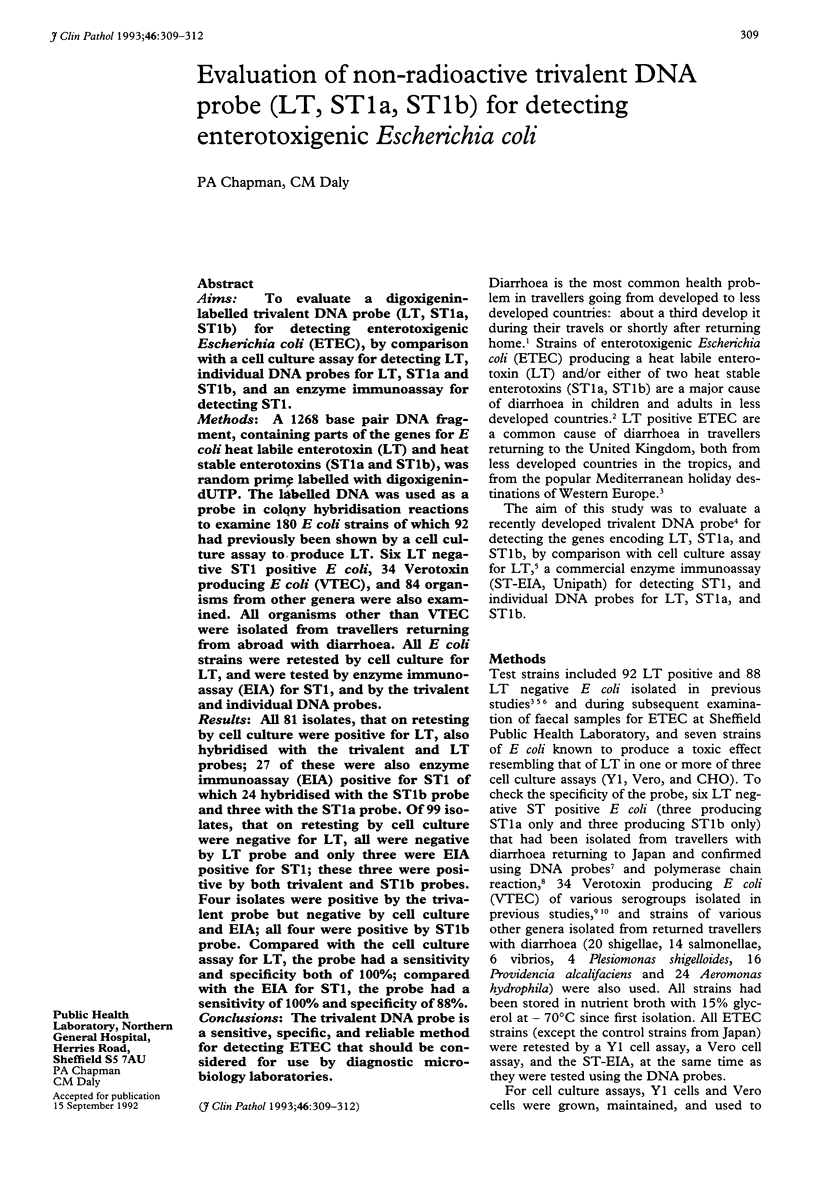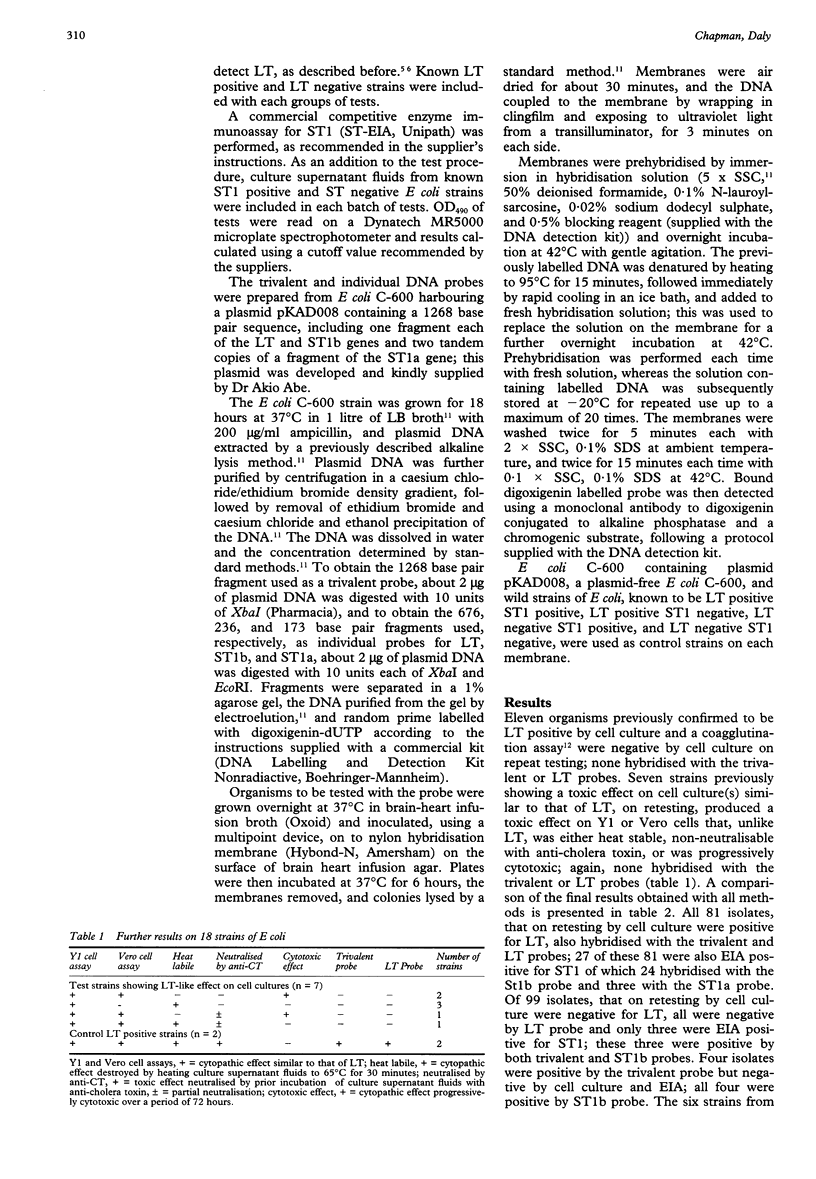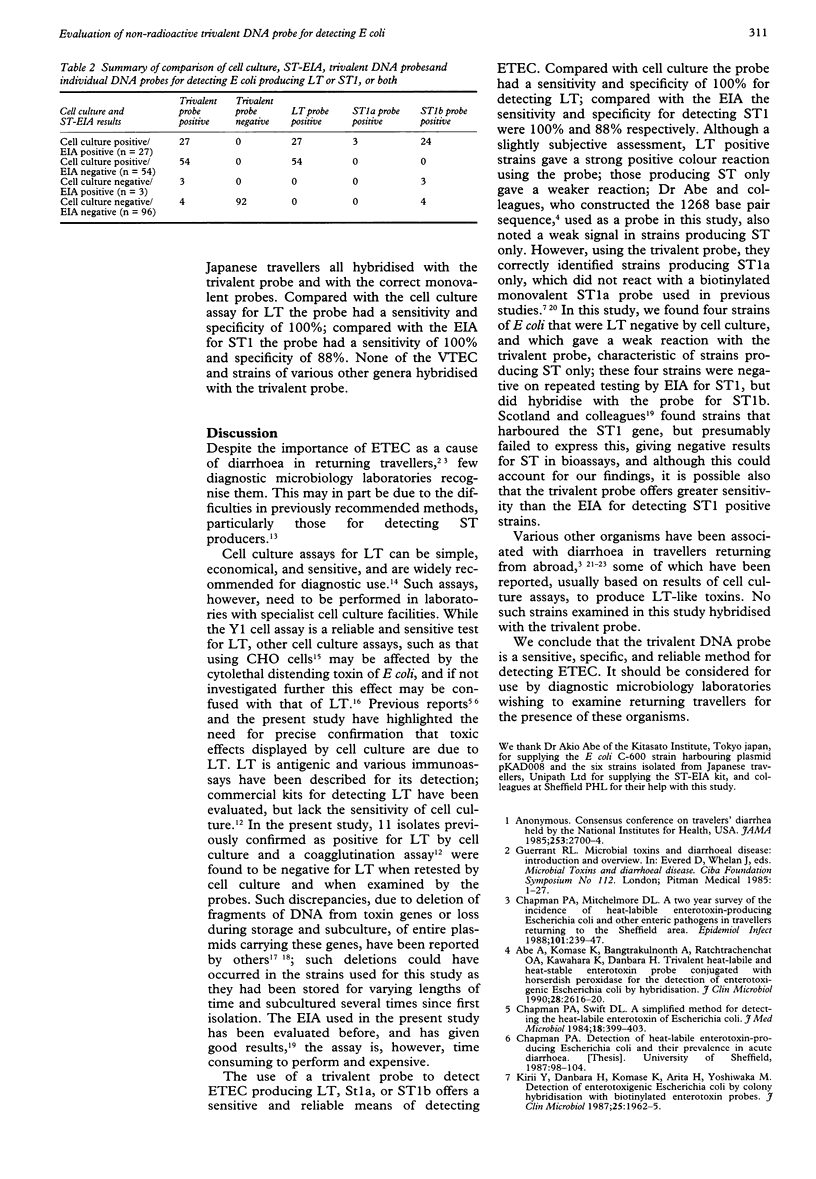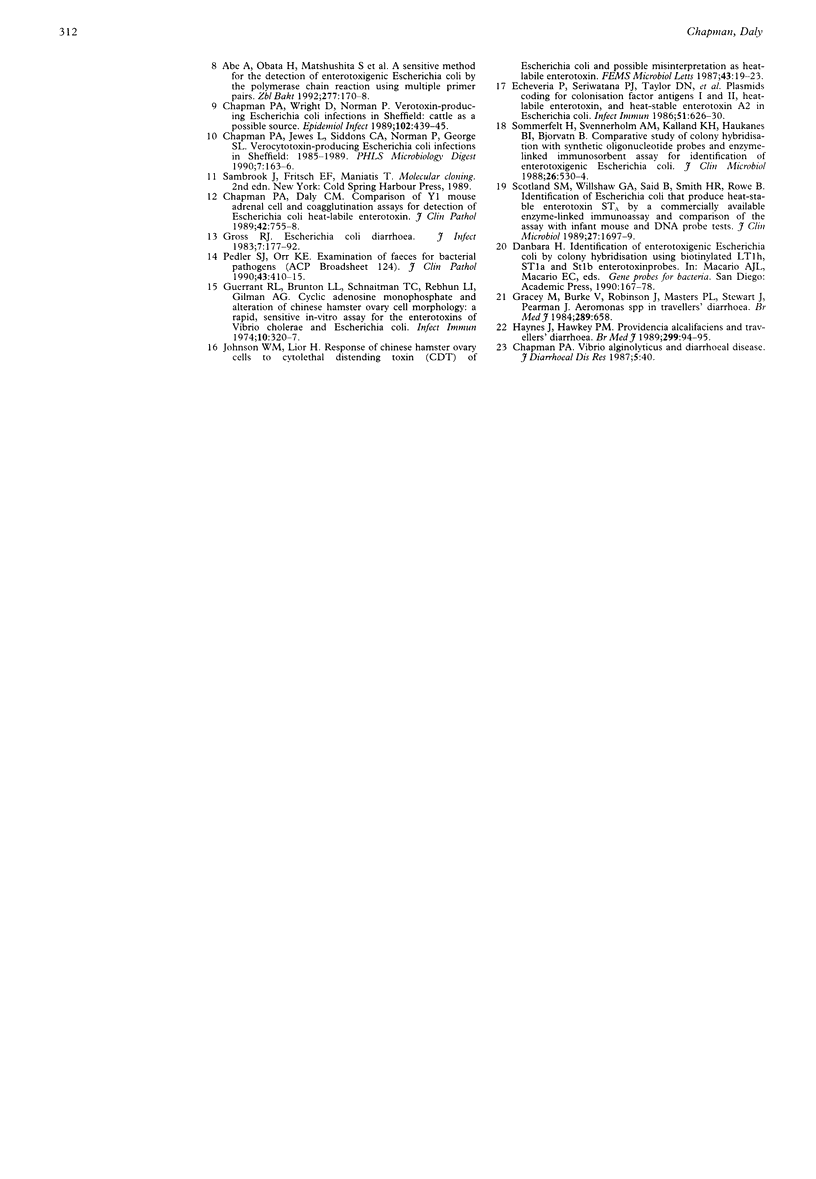Abstract
AIMS: To evaluate a digoxigenin-labelled trivalent DNA probe (LT, ST1a, ST1b) for detecting enterotoxigenic Escherichia coli (ETEC), by comparison with a cell culture assay for detecting LT, individual DNA probes for LT, ST1a and ST1b, and an enzyme immunoassay for detecting ST1. METHODS: A 1268 base pair DNA fragment, containing parts of the genes for E coli heat labile enterotoxin (LT) and heat stable enterotoxins (ST1a and ST1b), was random prime labelled with digoxigenin-dUTP. The labelled DNA was used as a probe in colony hybridisation reactions to examine 180 E coli strains of which 92 had previously been shown by a cell culture assay to produce LT. Six LT negative ST1 positive E coli, 34 Verotoxin producing E coli (VTEC), and 84 organisms from other genera were also examined. All organisms other than VTEC were isolated from travellers returning from abroad with diarrhoea. All E coli strains were retested by cell culture for LT, and were tested by enzyme immunoassay (EIA) for ST1, and by the trivalent and individual DNA probes. RESULTS: All 81 isolates, that on retesting by cell culture were positive for LT, also hybridised with the trivalent and LT probes; 27 of these were also enzyme immunoassay (EIA) positive for ST1 of which 24 hybridised with the ST1b probe and three with the ST1a probe. Of 99 isolates, that on retesting by cell culture were negative for LT, all were negative by LT probe and only three were EIA positive for ST1; these three were positive by both trivalent and ST1b probes. Four isolates were positive by the trivalent probe but negative by cell culture and EIA; all four were positive by ST1b probe. Compared with the cell culture assay for LT, the probe had a sensitivity and specificity both of 100%; compared with the EIA for ST1, the probe had a sensitivity of 100% and specificity of 88%. CONCLUSIONS: The trivalent DNA probe is a sensitive, specific, and reliable method for detecting ETEC that should be considered for use by diagnostic microbiology laboratories.
Full text
PDF



Selected References
These references are in PubMed. This may not be the complete list of references from this article.
- Abe A., Komase K., Bangtrakulnonth A., Ratchtrachenchat O. A., Kawahara K., Danbara H. Trivalent heat-labile- and heat-stable-enterotoxin probe conjugated with horseradish peroxidase for detection of enterotoxigenic Escherichia coli by hybridization. J Clin Microbiol. 1990 Dec;28(12):2616–2620. doi: 10.1128/jcm.28.12.2616-2620.1990. [DOI] [PMC free article] [PubMed] [Google Scholar]
- Abe A., Obata H., Matsushita S., Yamada S., Kudoh Y., Bangtrakulnonth A., Ratchtrachenchat O. A., Danbara H. A sensitive method for the detection of enterotoxigenic Escherichia coli by the polymerase chain reaction using multiple primer pairs. Zentralbl Bakteriol. 1992 Jul;277(2):170–178. doi: 10.1016/s0934-8840(11)80610-9. [DOI] [PubMed] [Google Scholar]
- Chapman P. A., Daly C. M. Comparison of Y1 mouse adrenal cell and coagglutination assays for detection of Escherichia coli heat labile enterotoxin. J Clin Pathol. 1989 Jul;42(7):755–758. doi: 10.1136/jcp.42.7.755. [DOI] [PMC free article] [PubMed] [Google Scholar]
- Chapman P. A., Mitchelmore D. L. A two-year survey of the incidence of heat-labile enterotoxin-producing Escherichia coli and other enteric pathogens in travellers returning to the Sheffield area. Epidemiol Infect. 1988 Oct;101(2):239–247. doi: 10.1017/s0950268800054157. [DOI] [PMC free article] [PubMed] [Google Scholar]
- Chapman P. A., Swift D. L. A simplified method for detecting the heat-labile enterotoxin of Escherichia coli. J Med Microbiol. 1984 Dec;18(3):399–403. doi: 10.1099/00222615-18-3-399. [DOI] [PubMed] [Google Scholar]
- Chapman P. A. Vibrio alginolyticus and diarrhoeal disease. J Diarrhoeal Dis Res. 1987 Mar;5(1):40–40. [PubMed] [Google Scholar]
- Chapman P. A., Wright D. J., Norman P. Verotoxin-producing Escherichia coli infections in Sheffield: cattle as a possible source. Epidemiol Infect. 1989 Jun;102(3):439–445. doi: 10.1017/s0950268800030156. [DOI] [PMC free article] [PubMed] [Google Scholar]
- Echeverria P., Seriwatana J., Taylor D. N., Changchawalit S., Smyth C. J., Twohig J., Rowe B. Plasmids coding for colonization factor antigens I and II, heat-labile enterotoxin, and heat-stable enterotoxin A2 in Escherichia coli. Infect Immun. 1986 Feb;51(2):626–630. doi: 10.1128/iai.51.2.626-630.1986. [DOI] [PMC free article] [PubMed] [Google Scholar]
- Gracey M., Burke V., Robinson J., Masters P. L., Stewart J., Pearman J. Aeromonas spp in travellers' diarrhoea. Br Med J (Clin Res Ed) 1984 Sep 15;289(6446):658–658. doi: 10.1136/bmj.289.6446.658. [DOI] [PMC free article] [PubMed] [Google Scholar]
- Gross R. J. Escherichia coli diarrhoea. J Infect. 1983 Nov;7(3):177–192. doi: 10.1016/s0163-4453(83)96953-0. [DOI] [PubMed] [Google Scholar]
- Guerrant R. L., Brunton L. L., Schnaitman T. C., Rebhun L. I., Gilman A. G. Cyclic adenosine monophosphate and alteration of Chinese hamster ovary cell morphology: a rapid, sensitive in vitro assay for the enterotoxins of Vibrio cholerae and Escherichia coli. Infect Immun. 1974 Aug;10(2):320–327. doi: 10.1128/iai.10.2.320-327.1974. [DOI] [PMC free article] [PubMed] [Google Scholar]
- Haynes J., Hawkey P. M. Providencia alcalifaciens and travellers' diarrhoea. BMJ. 1989 Jul 8;299(6691):94–95. doi: 10.1136/bmj.299.6691.94-a. [DOI] [PMC free article] [PubMed] [Google Scholar]
- Kirii Y., Danbara H., Komase K., Arita H., Yoshikawa M. Detection of enterotoxigenic Escherichia coli by colony hybridization with biotinylated enterotoxin probes. J Clin Microbiol. 1987 Oct;25(10):1962–1965. doi: 10.1128/jcm.25.10.1962-1965.1987. [DOI] [PMC free article] [PubMed] [Google Scholar]
- Pedler S. J., Orr K. E. ACP Broadsheet 124: May 1990. Examination of faeces for bacterial pathogens. J Clin Pathol. 1990 May;43(5):410–415. doi: 10.1136/jcp.43.5.410. [DOI] [PMC free article] [PubMed] [Google Scholar]
- Scotland S. M., Willshaw G. A., Said B., Smith H. R., Rowe B. Identification of Escherichia coli that produces heat-stable enterotoxin STA by a commercially available enzyme-linked immunoassay and comparison of the assay with infant mouse and DNA probe tests. J Clin Microbiol. 1989 Jul;27(7):1697–1699. doi: 10.1128/jcm.27.7.1697-1699.1989. [DOI] [PMC free article] [PubMed] [Google Scholar]
- Sommerfelt H., Svennerholm A. M., Kalland K. H., Haukanes B. I., Bjorvatn B. Comparative study of colony hybridization with synthetic oligonucleotide probes and enzyme-linked immunosorbent assay for identification of enterotoxigenic Escherichia coli. J Clin Microbiol. 1988 Mar;26(3):530–534. doi: 10.1128/jcm.26.3.530-534.1988. [DOI] [PMC free article] [PubMed] [Google Scholar]


